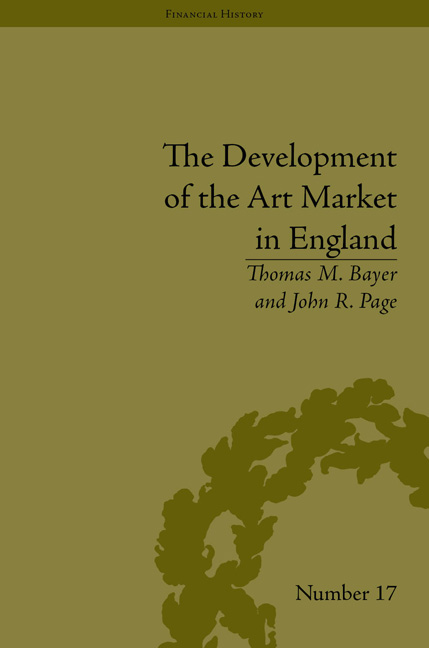Book contents
- Frontmatter
- CONTENTS
- Acknowledgements
- List of Figures and Tables
- Dedication
- Introduction
- 1 The Early Stages: From the Netherlands to Great Britain
- 2 The Commoditization of Theories of Art
- 3 The Painter as Homo Economicus
- 4 Critics and Auctions
- 5 The Evolution of Picture-Dealing
- 6 The Victorian Era
- 7 ‘Working the Oracle’: The Tools of the Trade
- 8 The Formation of a Nexus: A Story of Christie's
- 9 Commoditization and the Artist as Producer: Product Differentiation and the Domestication of Pictures
- 10 The End of the ‘Golden Age’
- 11 Postscript: A Perpetual Innovative Whirl
- Notes
- Works Cited
- Index
8 - The Formation of a Nexus: A Story of Christie's
- Frontmatter
- CONTENTS
- Acknowledgements
- List of Figures and Tables
- Dedication
- Introduction
- 1 The Early Stages: From the Netherlands to Great Britain
- 2 The Commoditization of Theories of Art
- 3 The Painter as Homo Economicus
- 4 Critics and Auctions
- 5 The Evolution of Picture-Dealing
- 6 The Victorian Era
- 7 ‘Working the Oracle’: The Tools of the Trade
- 8 The Formation of a Nexus: A Story of Christie's
- 9 Commoditization and the Artist as Producer: Product Differentiation and the Domestication of Pictures
- 10 The End of the ‘Golden Age’
- 11 Postscript: A Perpetual Innovative Whirl
- Notes
- Works Cited
- Index
Summary
In a rough analogy of the art market to the stock market painters are firms which produce products (here paintings rather than stocks or bonds), dealers are specialists and brokers, critics are analysts and the auction house is the stock exchange. Throughout most of the eighteenth century, the auction industry was characterized by the presence of numerous auctioneers disbursing collections generally assembled by middlemen to sell to the public. Liquidity sales appear to have been less frequent. The nineteenth-century scene, to the contrary, can be told as the story of one auction house – Christie's – primarily involved in the disposition of private estates to the trade.
This auction house alone conducted 92 per cent of all sales between 1840 and 1900 recorded by Graves: 90 per cent of all transactions involving Continental Old Masters; 92 per cent of sales of English Old Masters; 95 per cent of Contemporary Continental works and 93 per cent of Contemporary English paintings passed through Christie's. The remaining 8 per cent were spread across approximately thirty other firms. Since Graves recorded the top end of the market and only about 10 per cent of the estimated total volume of auction sales, we checked Graves's records against our records of the dealers Tooth and Agnew. Both data sets show that, indeed, Christie's was the overwhelmingly favoured auction house for these two dealers.
- Type
- Chapter
- Information
- The Development of the Art Market in EnglandMoney as Muse, 1730–1900, pp. 143 - 152Publisher: Pickering & ChattoFirst published in: 2014



